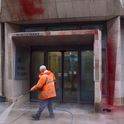Licensed, unlicensed and surrendered bombs
North Korea’s stand-off with Donald Trump is a stark reminder of the weapons that could wipe us all out. The map shows that the official nuclear powers have had some success in containing the geographical spread of atomic weapons since 1945. But during the first half of the nuclear era, bombs got much more numerous—and much more destructive. The largest “Tsar” bomb, which the Soviets tested in the 1960s, had a payload equivalent to 50Mt of TNT, making it over 3,000 times more powerful than the Hiroshima bomb. In more recent times, as the charts show, the world’s nuclear stockpile has shrunk. The number of bombs is down by more than three-quarters since the 1980s. Meanwhile, the typical contemporary US nuclear warhead is considerably smaller than a 1970s H-bomb.Bombs away

After a long arms race, the global nuclear stockpile has been shrinking since the 1980s.
Diameters of destruction

Bombs got bigger after Hiroshima—but their size has stabilised in more recent times.












